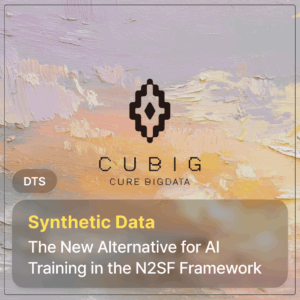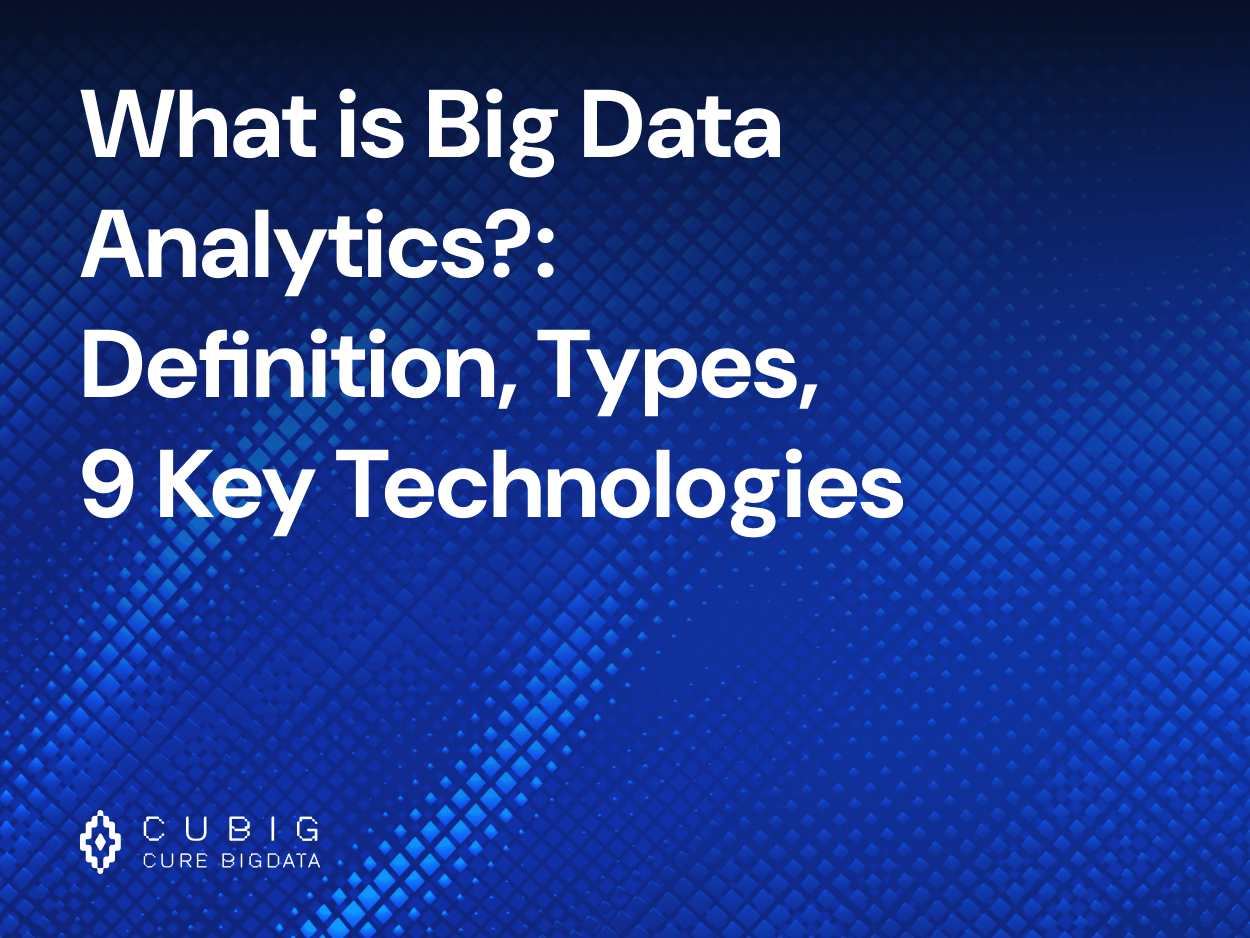What is Big Data Analytics?: Definition, Types, 9 Key Technologies
Table of Contents
Big data analytics is the process of examining large and diverse data sets to uncover valuable insights, patterns, and trends. With today’s vast and complex digital information, businesses rely on big data analytics technologies to make smarter decisions and drive innovation. In this guide, we’ll define big data analytics, explore its types and technologies, and show how Azoo AI helps businesses turn raw data into real results.
What is big data analytics?
Big data analytics involves analyzing extremely large data sets that traditional tools can’t handle efficiently. These analytics help organizations identify hidden patterns, market trends, customer preferences, and other useful business information.
Big data vs Traditional data
Big data and traditional data differ not just in size but in how they are generated, stored, processed, and analyzed. Understanding these differences helps businesses choose the right tools and strategies for their data needs.
Big data
Big data typically refers to massive volumes of data that are generated at high speed from a variety of sources such as social media, IoT devices, sensors, mobile apps, and transactional systems. This data is often unstructured or semi-structured, and it requires advanced tools like distributed computing systems to be processed and analyzed efficiently.
Traditional data
Traditional data is generally structured, originating from internal enterprise applications like CRM systems, ERP software, or relational databases. It’s well-organized in rows and columns, making it easy to store and analyze using conventional tools like SQL.
These two data types serve different purposes. Traditional data works well for day-to-day operations and reporting, while big data supports advanced analytics, real-time insights, and innovation-driven decision making.
| Feature | Big Data | Traditional Data |
|---|---|---|
| Volume | Massive, often in petabytes | Limited, typically in gigabytes |
| Structure | Structured, semi, and unstructured | Mostly structured |
| Processing | Distributed systems (e.g., Hadoop) | Single server or database |
| Speed | Real-time or near real-time | Batch processing |
| Big Data | Traditional Data | |
| —————- | ———————————- | ——————————- |
| Volume | Massive, often in petabytes | Limited, typically in gigabytes |
| Structure | Structured, semi, and unstructured | Mostly structured |
| Processing | Distributed systems (e.g., Hadoop) | Single server or database |
| Speed | Real-time or near real-time | Batch processing |
The 5Vs of Big Data
Understanding the 5Vs is essential to grasping the core principles of big data. These five characteristics define what makes data ‘big’ and guide how organizations manage and analyze it.
Volume
Refers to the sheer amount of data being created every second—from business transactions to social media posts, sensor data, and beyond. Managing this volume requires scalable storage and processing solutions.
Velocity
Describes the speed at which data is generated and moves through systems. Whether it’s a real-time stock feed or continuous IoT sensor data, fast processing is key to extracting timely insights.
Variety
Big data comes in all shapes and forms: text, audio, video, log files, clickstreams, and more. This variety makes it powerful but also more complex to manage and analyze.
Veracity
Relates to the quality and reliability of data. Inaccurate or incomplete data can lead to false conclusions, so organizations need strategies to clean and validate data.
Value
Ultimately, data must deliver business value. The ability to extract useful insights and make data-driven decisions is the goal of big data analytics.The ultimate goal: turning data into actionable insights.
Types of big data
Big data can be categorized based on its format and how easily it can be processed. Knowing the types helps in choosing the right storage and analytical tools.
Structured Data
Highly organized and stored in a fixed format, such as tables in relational databases. It’s easy to search and analyze using standard tools like SQL.
Semi-Structured Data
Has some organizational properties (like tags or markers) but doesn’t fit neatly into tables. Examples include JSON, XML, and NoSQL data formats. It’s more flexible than structured data but requires specialized tools.
Unstructured Data
Includes everything from videos, images, audio files to emails and social media posts. It lacks a predefined format and is the most complex to analyze, often requiring AI or natural language processing tools.No fixed format—includes images, video, emails, social posts.
Types of big data analytics
Understanding the different types of analytics helps organizations determine the right approach based on their goals—whether it’s reviewing the past, analyzing the present, or planning for the future.
Descriptive analytics
Answers: What happened? It focuses on summarizing raw historical data to identify patterns and trends. This is typically done through dashboards and reports.
Diagnostic analytics
Answers: Why did it happen? It digs deeper into data to find root causes and relationships. Often involves data mining and correlation analysis.
Predictive analytics
Answers: What might happen next? Uses historical data along with statistical models and machine learning to forecast future outcomes.
Prescriptive analytics
Answers: What should we do about it? It not only predicts outcomes but also recommends the best course of action using optimization and simulation.Answers: What should we do about it? Recommends actions.
Example of big data analytics
Big data analytics is applied across every major industry to optimize performance, personalize experiences, and reduce risk.
Banking
Used to detect fraudulent transactions, automate credit scoring, and personalize banking services using customer data.
Government
Helps enhance public services, forecast emergencies, and improve transparency and tax compliance.
Healthcare
Used to predict disease outbreaks, enhance diagnostic accuracy, and improve treatment plans and patient care.
Manufacturing
Enables predictive maintenance, supply chain optimization, and efficient resource allocation.
Retail
Analyzes consumer behavior to optimize product placements, pricing strategies, and inventory levels.
Sciences
Accelerates research by analyzing complex datasets in genomics, physics, climate science, and more.
Education
Personalizes learning content, predicts student performance, and supports administrative planning.
Sports
Improves athlete performance, strategizes game play, and enhances fan engagement through real-time data.Improve performance, strategy, and fan experience.
How does big data analytics work?
Big data analytics follows a multi-step workflow that transforms raw data into business insights.
Data collection
This first step involves gathering data from a variety of sources like sensors, websites, mobile apps, social media, and enterprise systems.
Data processing
The collected data is cleaned, formatted, and sometimes enriched. This makes it consistent and usable for analysis.
Analytical modeling
Here, algorithms or statistical techniques are applied to identify correlations, patterns, or predictions.
Insight generation
Results from modeling are visualized or reported so stakeholders can understand them and make data-informed decisions.Visualize results, generate reports, and take action.
Key big data analytics technologies
These technologies form the backbone of big data systems. They help store, manage, process, and analyze data at scale.
Hadoop
A foundational big data framework that distributes storage and processing tasks across clusters of computers.
Apache Spark
Provides faster processing by performing tasks in-memory, ideal for real-time analytics.
Cloud Computing
Enables on-demand scalability and flexibility for big data workloads, without the need for physical infrastructure.
Artificial Intelligence (AI) and Machine Learning (ML)
Automate data analysis to uncover patterns and make predictions from complex datasets.
Data Lakes
A centralized repository that stores raw data in its original format for future use or deep analysis.
NoSQL Databases
Designed to store and query non-relational data types, ideal for semi-structured and unstructured data.
Data Warehousing
Supports long-term storage of structured data, enabling efficient business reporting and historical analysis.
IoT Analytics
Processes large volumes of data generated from internet-connected devices and sensors.
Blockchain for Big Data
Adds a layer of security and traceability to data transactions, ensuring integrity in data-sharing environments.Provides secure, auditable data trails.
Best big data analytics tools
These tools help users—from analysts to engineers—gain insights from large, complex datasets using intuitive interfaces or advanced modeling.
Azoo AI
A next-generation analytics platform that simplifies data transformation, integration, and insight delivery with enterprise-grade governance.
ThoughtSpot
Lets users explore data through search-based queries and AI-generated insights.
Microsoft Power BI
Offers rich dashboards and integrations with Microsoft’s data ecosystem.
Tableau
Helps visualize complex data through drag-and-drop charts and dashboards.
Qlik Sense
Supports associative exploration for uncovering hidden relationships in data.
Apache Hadoop
Popular open-source ecosystem for distributed data storage and batch analytics.
Apache Spark
Excels in processing large datasets at high speed, suitable for both batch and stream processing.
RapidMiner
An easy-to-use platform for building predictive models with minimal coding.
KNIME
Modular and open-source, ideal for visual programming of machine learning workflows.Modular platform for data science and machine learning.
Benefits of big data analytics and why it matters
Big data analytics provides measurable benefits across operations, innovation, and customer engagement.
Reducing cost
Through operational efficiency, predictive maintenance, and waste reduction, analytics helps cut costs and streamline resources.
Making faster, better decisions
Access to real-time data and advanced forecasting supports quicker, more confident business choices.
Creating and marketing new products and services
Helps identify customer needs and market gaps earlier, accelerating time-to-market and improving personalization.Spot opportunities faster than competitors.
Challenges of big data analytics
Despite its benefits, big data analytics presents several obstacles that organizations must actively manage.
Data quality issues
Poor-quality data can skew analysis and lead to wrong decisions. Ensuring accuracy and consistency is essential.
Data access and integration difficulties
Combining data from diverse systems and formats can be technically complex and time-consuming.
Inadequate data visualization
Without proper visualization tools, stakeholders may find it hard to interpret raw analytical output.
Privacy and Security concerns
Big data often includes sensitive information that must be protected to comply with regulations and maintain trust.
Storage and Scalability challenges
As data grows, infrastructure must scale without compromising performance or cost-efficiency.
Shortage of skilled personnel
There’s a global gap in experienced data scientists, engineers, and analysts who can design and operate advanced analytics systems.
Ethical and compliance issues
Organizations must ensure that their data practices align with laws and ethical standards around consent, bias, and usage.
🛠️ Azoo AI simplifies these challenges with scalable tools, strong governance, and intuitive analytics workflows.Collecting and using data responsibly is essential.
🛠️ Azoo AI simplifies these challenges with scalable tools, strong governance, and intuitive analytics workflows.
Curious how Azoo AI can boost your data intelligence? Contact us to learn more.
CUBIG's Service Line
Recommended Posts
-

Launching LLM Capsule for macOS: using generative AI at work while staying compliant with privacy regulations
-

Synthetic data AI training: a new path for public institutions in the N2SF era
-

Why Public Institutions Need DTS for Safe Data Opening & Utilization(feat. 2025 Public Data Provision & Data-Driven Administration Evaluation Guidelines)






